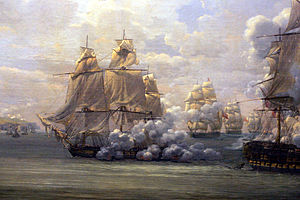Surrender of Cap Français
| Blockade of Saint-Domingue | |||||||
|---|---|---|---|---|---|---|---|
| Part of the Haitian Revolution & the Napoleonic Wars | |||||||
 Detail from the Fight of the Poursuivante against the British ship Hercules, 28 June 1803. Louis-Philippe Crépin, 1819, Musée national de la Marine |
|||||||
|
|||||||
| Belligerents | |||||||
|
|
|
||||||
| Commanders and leaders | |||||||
|
|
|
||||||
| Strength | |||||||
|
2 Squadrons:
|
2 ships of the line, 6 frigates, 35 ships & transports, 7,000 soldiers |
||||||
| Casualties and losses | |||||||
| unknown but low |
1 ship of the line, 6 American & 2 Danish ships captured |
||||||
Decisive Anglo-Haitian victory
2 Squadrons:
1 ship of the line,
4 frigates,
31 other ships captured,
6,000 captured,
unknown sick
The Blockade of Saint-Domingue was a naval campaign fought during the first months of the Napoleonic Wars, in which a series of British Royal Navy squadrons blockaded the French-held ports of Cap Français and Môle-Saint-Nicolas on the Northern coast of the French colony of Saint-Domingue, shortly to become Haiti following the conclusion of the Haitian Revolution on 1 January 1804. In the summer of 1803, when war broke out between the United Kingdom and the French Consulate, Saint-Domingue had been almost completely overrun by Haitian forces under the command of Jean-Jacques Dessalines. In the north of the country, the French forces were isolated in the two large ports of Cap Français and Môle-Saint-Nicolas and a few smaller settlements, all supplied by a French naval force based primarily at Cap Français.
At the outbreak of war on 18 May 1803, the Royal Navy immediately despatched a squadron under Sir John Duckworth from Jamaica to cruise in the region, seeking to eliminate communication between the French outposts and to capture or destroy the French warships based in the colony. On 28 June, the squadron encountered a French convoy from Les Cayes off Môle-Saint-Nicolas, capturing one ship although the other escaped. Two days later an independently sailing French frigate was chased down and captured in the same waters. On 24 July another British squadron intercepted the main French squadron from Cap Français, which was attempting to break past the blockade and reach France. The British, led by Commodore John Loring gave chase, but one French ship of the line and a frigate escaped. Another ship of the line was trapped against the coast and captured after coming under fire from Haitian shore batteries. The remainder of the squadron was forced to fight two more actions on their return to Europe, but did eventually reach the Spanish port of Corunna.
...
Wikipedia
